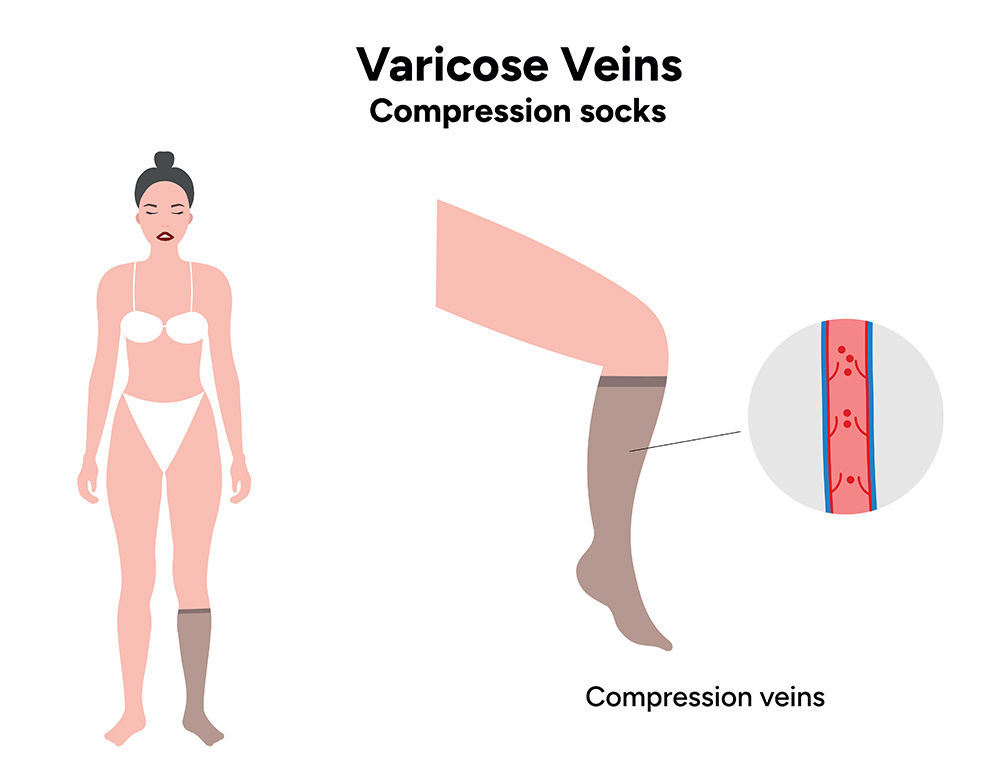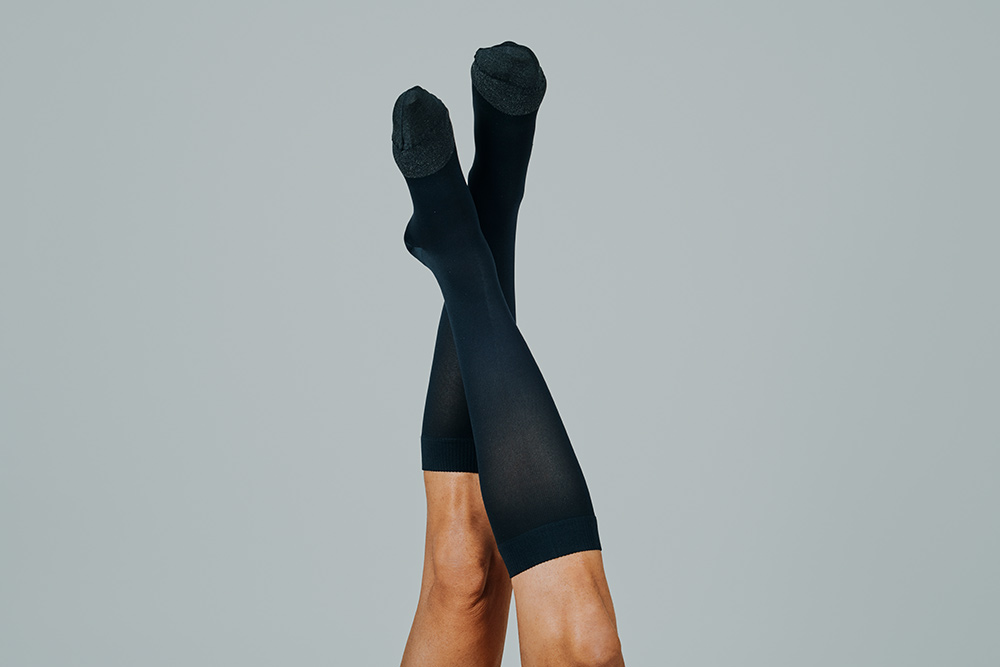Table of Contents
ToggleLast updated on October 22, 2025
At Vein Doctors Sydney, many patients come to us seeking relief from leg discomfort, varicose veins, or concerns about deep vein thrombosis (DVT). One of the most common first-line solutions we recommend is surprisingly simple: compression socks.
Though they may look like regular long socks, compression stockings are specially designed medical garments that apply graduated pressure to your legs. They help improve circulation, reduce swelling, and alleviate discomfort. But how exactly do they work, and what conditions do they help with?
In this article, we’ll break down how compression socks support vein health, what conditions they help with, the different types available, and how they fit into a broader treatment plan offered at Vein Doctors Sydney.
What Do Compression Socks Do?
Compression socks apply graduated pressure to the legs, meaning they’re tightest at the ankle and gradually loosen higher up the leg. This controlled pressure supports veins and muscles in moving blood back toward the heart, preventing blood from pooling in the lower limbs.
For many people, this improved circulation translates into reduced leg fatigue, less swelling, and relief from that heavy, aching feeling that can build up after standing or sitting for long periods. That’s why compression socks for circulation are recommended for people with venous conditions, sedentary jobs, or those recovering from surgery.
So, what do compression socks do exactly? In simple terms, they help your blood flow more efficiently, reduce venous pressure, and minimise fluid build-up, making them a powerful tool for managing or preventing a range of vascular issues.
Compression Socks Benefits: More Than Just Support
The benefits of compression socks extend beyond temporary symptom relief. When worn regularly and correctly, they may help:
Reduce the risk of developing deep vein thrombosis (DVT)
Beneficial, especially during long flights, bed rest, or post-surgery recovery. By improving blood flow and preventing blood pooling in the legs, compression socks help reduce clot formation.
Manage symptoms of chronic venous insufficiency (CVI)
These may include swelling, throbbing, aching, and night-time leg cramps. Compression socks for circulation work by gently squeezing the legs to support healthy venous return.
Prevent varicose veins from worsening
Useful, particularly in the early stages. While they don’t eliminate visible veins, they can ease discomfort and help delay the need for invasive procedures.
Improve comfort during pregnancy or in physically demanding jobs
The added support helps reduce swelling and fatigue caused by prolonged standing.
Support athletic recovery and performance
Graduated compression enhances circulation, helping to clear metabolic waste more quickly and reduce post-exercise soreness.
For many people, the purpose of compression socks is preventive. By improving blood flow, reducing venous congestion, and supporting the natural pumping action of the calf muscles, compression socks play a key role in long-term leg health.

Compression socks can be used for varicose veins, DVT prevention and recovery as well as leg swelling, pain and fatigue.
Compression Therapy for Specific Conditions
Compression Socks for Varicose Veins
Varicose veins occur when vein valves become damaged, allowing blood to flow backward and collect in the veins, causing them to bulge. If left unmanaged, varicose veins can cause significant discomfort and cosmetic concerns.
Compression stockings work by applying external pressure that supports vein walls and keeps blood moving in the right direction. This reduces venous pooling, swelling, and the sensation of heaviness in the legs. While they won’t make existing varicose veins disappear, they play a critical role in symptom management and can prevent progression of the condition.
For early-stage cases or those not yet ready for sclerotherapy or laser procedures, compression socks for varicose veins offer a non-invasive, low-risk treatment option. Compression stockings are also essential in the recovery phase to help support proper healing.
Compression Socks for DVT Prevention and Recovery
Deep vein thrombosis (DVT) is a serious condition in which a blood clot forms in a deep vein, often in the lower leg. These clots can break loose and travel to the lungs, resulting in a life-threatening pulmonary embolism.
Wearing compression stockings after surgery, during long flights, or when immobile can lower this risk by encouraging blood to keep moving through the veins. Post-DVT compression can also prevent post-thrombotic syndrome (PTS), which leads to chronic swelling, pain, and skin changes.
If you’ve experienced a DVT event or are at increased risk, your doctor may recommend medical-grade graduated compression stockings to help prevent recurrence.
Compression Socks for Leg Swelling, Pain, and Fatigue
Even if you don’t have a diagnosed venous condition, compression socks can relieve swelling and pain from everyday life. If you’ve ever felt your legs grow tired or heavy after a long day on your feet, compression can help.
These socks are especially beneficial for:
- Pregnant individuals experiencing lower leg swelling
- People with desk jobs who sit for long periods
- Frequent travellers on long-haul flights
- Athletes aiming for faster recovery after intense workouts
By improving circulation and reducing the build-up of fluid in the lower limbs, compression socks can dramatically improve comfort and recovery.

Compression stocks vary by length, pressure level and intended use.
Types of Compression Stockings: Choosing What’s Right for You
There are several types of compression stockings, each designed for different purposes and medical needs. They vary by length, pressure level (measured in mmHg), and intended use.
The most common type for medical conditions is the graduated compression stocking, which offers firm ankle pressure that eases as it moves up the leg. These are ideal for people managing varicose veins, swelling, and CVI.
Another variant is the anti-embolism stocking, used primarily in hospital settings or after surgery to prevent clotting. These are different from everyday compression socks and typically used short-term.
There are also athletic compression socks, designed to boost blood flow during exercise and help flush out lactic acid during recovery.
In terms of length, options include:
- Knee-high stockings, commonly used for varicose veins or mild swelling
- Thigh-high or full-length stockings, recommended for extensive leg swelling or more severe cases of venous insufficiency
A vascular specialist or GP can help determine which compression level and style is best suited for your individual needs.
How Do Compression Stockings Work in Combination With Other Treatments?
Compression stockings are often a first-line, non-invasive strategy for managing symptoms of varicose veins and preventing complications of deep vein thrombosis (DVT). But they are not a cure for these conditions.
Instead, they are most effective when used in conjunction with other evidence-based treatments, either to prepare for a procedure, assist recovery, or help maintain results. Here’s how they fit in:
Can Compression Socks Cure Varicose Veins or DVT?
Compression stockings do not eliminate varicose veins or dissolve blood clots caused by DVT. However:
For varicose veins, they reduce symptoms like swelling, heaviness, and discomfort, and may help slow the progression in early stages.
For DVT, they reduce the risk of clot formation and may help prevent complications like post-thrombotic syndrome (PTS). a long-term condition causing leg pain, swelling, and skin changes.
For more definitive treatment, procedures such as sclerotherapy, endovenous laser ablation or ambulatory phlebectomy may be required for varicose veins and thrombolysis or endovascular thrombectomy may be required for DVT.
How to Book an Appointment
At Vein Doctors Sydney, we are committed to providing personalised and compassionate care for patients seeking treatment for varicose veins, DVT or leg pain. For more information on our services or to schedule a consultation at our clinic, please contact our friendly staff by either calling us on (02) 9023 9970, via our online form or by sending us an email.
Frequently Asked Questions
What do compression socks do for circulation?
Compression socks apply graduated pressure to the lower legs, helping blood return to the heart more efficiently. This reduces venous pooling, supports vein walls, and can relieve symptoms like swelling and heaviness, especially in people with varicose veins or chronic venous insufficiency.
How do compression socks work after vein treatments?
After procedures like sclerotherapy or laser ablation, compression stockings help minimise swelling, improve healing, and enhance treatment outcomes. Your vein specialist may recommend wearing them for a specific period post-treatment to support optimal recovery.
What type of compression stockings should I use?
There are various types, including knee-high, thigh-high, and full-length stockings. Compression levels are measured in mmHg, ranging from mild (8–15 mmHg) to medical-grade (20–30+ mmHg). Your doctor or vein specialist can help determine the best option based on your condition.
Are compression socks safe to wear all day?
Yes, most people can safely wear compression socks during the day, especially if they stand for long hours, travel frequently, or experience leg pain. However, compression socks should be removed at night unless directed otherwise by a healthcare professional.
Can anyone wear compression socks, or do I need a prescription?
Many compression socks, especially lower-grade options (below 20 mmHg), are available over the counter and can be used safely for general leg fatigue, mild swelling, or travel. However, medical-grade compression stockings (20 mmHg and above) may require a prescription or fitting by a vein specialist
This information is not intended to be used for diagnosis or treatment. It is aimed at presenting a perspective only and is not a substitute for a prescription. Anyone experiencing a medical condition should consult their doctor.

